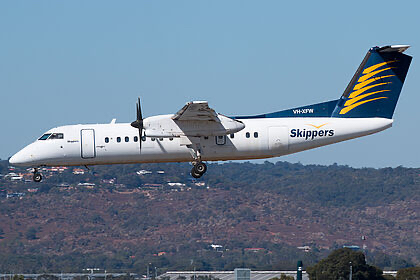Overview
• Operator: Skippers Aviation
• Aircraft Model: Swearingen SA-227-DC Metro 23
• Registration: VH-WAJ
• Flight Number: PY-6002
• Route: Forrestania (WA) to Perth (WA)
• Date: 12 August 2024
• Occupants: 4 passengers, 2 crew
• Casualties: None reported
• Nature of Incident: Complete hydraulic failure, subsequent taxiing accident
Incident Summary
A Skippers Aviation Swearingen SA-227-DC Metro 23, operating as flight PY-6002, was nearing top of descent into Perth when the aircraft experienced a complete hydraulic system failure. The crew conducted an emergency checklist, entered a holding pattern, and prepared for a manual gear extension and flapless landing.
The aircraft landed safely on Perth’s runway 24 and vacated onto taxiway A. The crew initially requested a tow but, due to an inability to establish communication with ground services, the captain mistakenly assumed hydraulic pressure had returned after a brief brake test. The captain opted to taxi the aircraft to the apron, unaware that the brake accumulator had been depleted.
While taxiing on a downhill gradient, the aircraft accelerated unexpectedly. Both crew members applied the brakes, but they were ineffective. The captain briefly engaged reverse thrust, then feathered the propellers and shut down the engines just before the aircraft collided with a hangar. The right wingtip and propeller sustained minor damage, but no injuries were reported.
The aircraft remained out of service for 30 days before returning to operation on 11 September 2024.
Sequence of Events
Pre-incident Conditions:
• The aircraft was operating a non-scheduled charter flight from Forrestania to Perth under routine conditions.
• No prior technical issues were reported before the flight.
In-flight Occurrence:
• During descent into Perth, the crew observed a complete loss of hydraulic pressure, affecting:
• Landing gear extension (requiring manual deployment).
• Flap operation (resulting in a flapless landing).
• Nose wheel steering (requiring alternative ground handling measures).
• Braking system, which relied on a reserve accumulator for limited braking capability.
• The crew entered a hold to prepare for a manual gear extension and a non-standard landing.
Landing & Emergency Response:
• The aircraft landed safely on runway 24 and vacated onto taxiway A.
• The crew requested ground inspection and a tow truck, but communication issues prevented immediate coordination.
• A brief brake test indicated residual pressure, leading the captain to assume the brakes were functional.
• The aircraft proceeded to taxi towards the apron but encountered an unexpected acceleration on a downhill slope.
• The crew attempted to brake, but the system was ineffective.
• The captain briefly applied reverse thrust before feathering the props and shutting down the engines.
• The aircraft collided with a hangar, sustaining minor damage to the right wingtip and propeller.
Investigation & Final Report Findings
On February 21, 2025, the ATSB (Australian Transport Safety Bureau) released its final report, concluding that the probable causes of the incident were:
1. Hydraulic system failure:
• A crack in a hydraulic line led to a complete loss of hydraulic pressure, requiring manual emergency procedures.
2. Crew workload and decision-making:
• The captain assumed both the pilot flying and pilot monitoring roles, significantly increasing workload.
• The first officer’s inexperience limited their ability to assist in managing the emergency.
• This reduced crew resource management (CRM) effectiveness, placing additional pressure on the captain.
3. Post-landing decision to taxi:
• After stopping on the taxiway, the captain mistakenly believed the brakes were functioning and opted to taxi instead of waiting for a tow.
• The absence of a confirmed hydraulic fluid leak and a false positive pressure indication led to misjudgment of brake functionality.
• The lack of communication with ground support created self-imposed pressure to clear the taxiway and reach the apron.
4. Runaway taxi and hangar collision:
• While taxiing downslope, the aircraft gained unintended speed, and the brakes failed to respond.
• The crew attempted to slow the aircraft using reverse thrust and propeller feathering, but this was insufficient to prevent the collision.
Analysis & Safety Recommendations
• Crew workload management:
• The incident highlights the challenges of single-pilot decision-making during critical emergencies, particularly when managing a high-workload event with an inexperienced first officer.
• Future training should emphasize CRM strategies for handling hydraulic failures, including clear delegation of duties.
• Hydraulic system integrity:
• The hydraulic failure resulted from a cracked hydraulic pipe union flare, emphasizing the importance of regular component inspections and preventive maintenance.
• Post-landing protocol for hydraulic failures:
• Aircraft with hydraulic failures should be towed whenever possible.
• Operators should reinforce post-landing brake system verification procedures before taxiing under suspected hydraulic failure conditions.
• Emergency response coordination:
• Improved communication protocols between pilots and ground services are necessary to ensure coordination during abnormal situations.
• Alternative means of communication should be available if radio contact with ground services is lost.
Disclaimer
“This report is based on available information as of 21 February 2025. While every effort has been made to ensure accuracy, the completeness of the details cannot be guaranteed. If you are the rightful owner of any referenced materials and wish them removed, please email takedown@cockpitking.com.”
